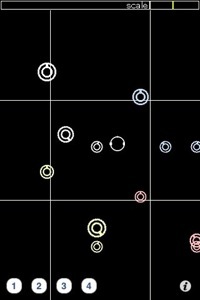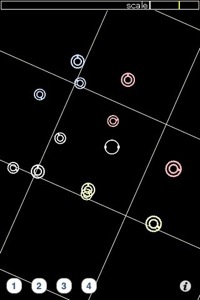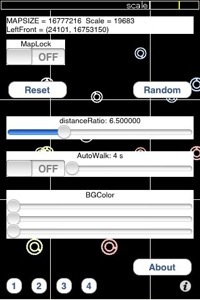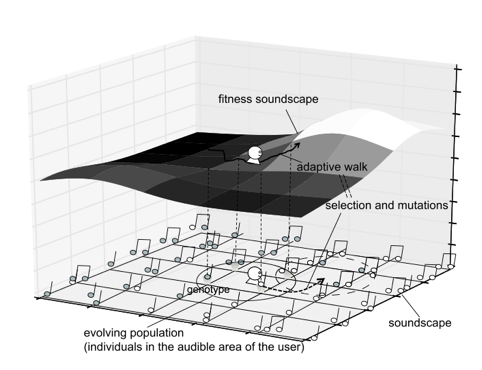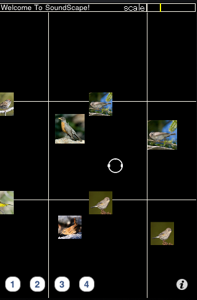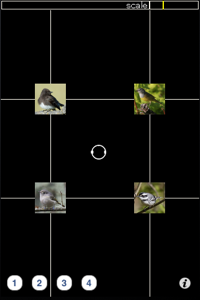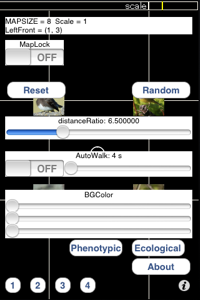---Summary---
iSoundScape is a new kind of interactive
evolutionary computation (IEC) for musical works, which is
inspired from a biological metaphor, adaptive walk on
fitness landscapes.
This application enables you to explore your
favorite musical works by walking through a virtual
landscape of sounds called a fitness soundscape.
There is a virtual two-dimensional plane that
represents the genetic space of possible musical works.
Several sound sources are placed near corresponding genotype
positions, each specifying the kind of sounds and its
relative location from the genotype. As you stand on the
soundscape realized by the openAL with a head phone, you can
hear sets of sounds generated from your neighboring
genotypes at the same time. These sounds come from different
directions depending on their relative position from you,
and are played repeatedly.
By using the human abilities for localization
and selective listening, you can walk in the direction of
your favorite sounds. Because each newly appearing
combination of sounds is similar but slightly different from
your previous choice, you can choose more favorite one among
them. Thus, adaptive walk through this landscape corresponds
to the evolutionary process of the population in standard
IECs.
iSoundScape_BIRD is a variant of iSoundScape
that provides a new way to explore the ecology and evolution
of bird songs, from scientific and educational viewpoints,
by exploring the ecological space of “nature's music”,
produced by populations of virtual songbirds from Northern
California. There are 16 species, and 4 different song clips
and a beautiful picture for each species. A listener is able
to explore the soundscape and virtual ecology of multiple
individuals of songbirds.
---Snap shots---
iSoundScape
iSoundScape_BIRD
---How to play---
[Adaptive walk]
After evaluating the musical pieces generated
by the nearest four genotypes, a listener can change its
location on the soundscape by dragging its icon. The
directions of sounds coming from sound sources change
dynamically according to the relative position of the
listener during the movement. If the icon is moved outside
of the central area of the grid, the soundscape scrolls by
one unit of the grid. The sound sources of the next four
neighboring genotypes are then displayed and begin to play.
[Rotation]
By swiping a finger outside of the center area
in a clockwise or counterclockwise direction, a listener can
rotate the whole soundscape by 90 degrees. By changing the
orientation of the surrounding sound sources in this way, a
listener can utilize the right / left stereo environment of
the iPhone for localizing sounds that were previously in
front of / behind the listener.
[Scale change of the soundscape]
By pinching in or out any place on the screen,
a listener can decrease or increase the scale of the
soundscape. It changes the Hamming distance between the
nearest neighboring genotypes by skipping the closest
genotypes and selecting distant genotypes. The decrease in
the scale ratio enables the listener to evaluate more
different individuals at the same time, and jump to a more
distant place quickly. Conversely, increasing the scale
ratio allows the listener to refine the existing musical
pieces by evaluating more similar genotypes.
[Shape change of the soundscape]
(implemented only in iSoundScape_BIRD)
A user can change the shape of the soundscape
by modifying the genotype-phenotype mapping. Every time the
user shakes the iPhone or iPad, the position of each bit in
the genotype that corresponds to each property of the sound
sources is right-shifted cyclically by two bits. Then, the
user jumps to the location on the soundscape based on the
new genotype-phenotype mapping so that the sound sources of
the genotype in the user's front left position are kept
unchanged. This enables the user to explore a wide variety
of mutants of the current population.
[Bookmark of a location]
If a listener touches one of the four buttons
on the bottom left in the screen, they can save the current
position, scale and direction of the soundscape as a kind of
bookmark. One previously bookmarked state can be loaded as
the current state of the user.
[Settings] Touch the button on the bottom
right, and
configure several options as follows:
[Map lock]
If it is set to ON, the soundscape
does not scroll even
when a listener comes out from the
center area.
[Reset location]
A listener goes back to the
initial position.
[Random location]
A listener goes to a random
position.
[Background color]
A listener can change the
background color.
[Distance ratio]
This determines the maximum
distance that each sound can reach.
[Auto walk]
If it is set to ON, a listener
automatically and randomly walks
every time interval specified by
the slider.
[Selection of soundscape]
Only in iSoundScape_BIRD, you can
choose a soundscape from
phenotypic or ecological
soundscapes
---Genetic description of the sound---
Each genotype is placed on its unique position
on the soundscape so that closer genotypes are placed on
nearer positions.
Each genotype determines the kinds of sounds,
volumes, and the relative positions of the three sound
sources.
Each sound source is represented as a circle
with a tab which indicates the kind of the sound. The size
of circle also represents the volume of the
sound source.
The possible sounds in iSoundScape are:
piano, bass, synth (CDEFGABC)
drums (8 different patterns)
SE (laughter, clock, birdsong, water,
etc.)
In iSoundScape_BIRD, we have constructed two
different soundscapes from these song clips. Each reflects a
phenotypic or ecological property of birdsongs. In addition
to providing an interesting way to explore birdsongs, the
first soundscape was developed to provide a way to
understand how properties of birdsongs could vary among
species in a soundscape. We assumed a two-dimensional
phenotypic space of birdsongs (as above). The axes in this
space reflect roughly two basic properties of birdsongs: the
length of songs and the intermediate frequency of songs.
Instead of using genotypes, we directly mapped the all song
clips to a 8x8 two-dimensional soundscape so that squared
clusters of four song clips of each species are arranged
according to the phenotypic space. Thus, each genotype is
composed of a set of two integer values, each corresponding
to the x or y location within the phenotypic space.
As for the second one, we replaced the
original sound clips in the iSoundScape with the clips of
birdsongs. To do so, we assumed that the first 4 bits in the
substring for each sound source in a genotype represent the
species, reflecting the topology of the phenotypic space,
and the next 2 bits represent a unique number of song clips
in the species. We also changed the number of sounds for
each genotype from three to two. Thus, the soundscape
comprises a 2^16 x 2^16 grid.
%We also reversed the bit order of the
substring for y location of the genotype before mapping it
to an integer value so that x and y axes correspond to
variations in different properties of individuals.
In this case, each genotype is composed of a
32 length bit string representing an ecological situation
involving two birds, and is mapped to both individual birds
singing different songs at different locations. Thus, a
listener is able to explore the soundscape and virtual
ecology of multiple individuals of songbirds.
In both cases, we inserted a random interval
between the start times of songs from each bird to
approximate the variation found in many natural soundscapes.
We used a small picture to represent the
species of each individual. These pictures are provided by
Neil Losin and Greg Gillson from their collections of bird
pictures (http://www.neillosin.com/,
http://www.pbase.com/gregbirder/)}.
This allows the listener to recognize the distribution of
birds on the soundscape.
---About iSoundScape and iSoundScape_BIRD---
iSoundScape was created and developed by
Soichiro Yamaguchi, as a part of his graduation work in
School of Information Science, Nagoya University. The
original concept of the "Fitness Soundscape" is created by
Arita-Suzuki Lab. in Graduate School of Information Science,
Nagoya University.
iSoundScape_BIRD was developed as a
collaborative work with Prof. Charles Taylor and Prof.
Martin Cody in UCLA. The sound clips are recorded by Prof.
Cody in Amador 2010.
We thank Neil Losin and Greg Gillson, who
allowed us to use the beautiful pictures of songbirds from
their collections. (from Neil Losin: Black-headed cowbird,
Spotted towhee, Wilson’s warbler, Yellow-rumped warbler,
American Robin, Nashville Warbler, Warbling vireo, Black
phoebe, http://www.neillosin.com/)
(from Greg Gilson: Orange-crowned warbler,
Black-headed grosbeak, Chipping sparrow, Black-throated gray
warbler, MacGillivray’s warbler, Cassin’s vireo, Hutton’s
vireo, Winter wren, http://www.pbase.com/gregbirder/)
Also, we thank Zac Harlow, who gave fruitful
comments and advice for development of iSoundScape¥_BIRD
For Any questions and comments, please send an
e-mail to: Reiji Suzuki (reiji@nagoya-u.jp)
---Publications---
Reiji Suzuki, Martin, Martin L. Cody, Charles
E. Taylor and Takaya Arita: "iSoundScape: Adaptive Walk on a
Fitness Soundscape", Applications of Evolutionary
Computation, LNCS 6625 (Proc. of the 9th European Event on
Evolutionary and Biologically Inspired Music, Sound, Art and
Design (evomusart2011)), pp. 404-413 (2011/04). [PDF]
Reiji Suzuki and Takaya Arita: "Adaptive Walk on Fitness
Soundscape", Post-proceedings of the Tenth European
Conference on Artificial Life (ECAL2009), LNAI5778 , pp.
94-101 (2011/09) [PDF]
---Related Resources---
ALIFE-CORE (Arita-Suzuki Lab. in Graduate
School of Information Science, Nagoya University)
http://www.alife.cs.is.nagoya-u.ac.jp/


